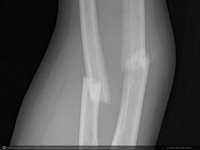Posted by Horton Tatarian, research biochemist, on 8th Sep 2015
Strengthen Your Bones, Part 2

Part 1 covered measures to build bones. However, avoiding and eliminating toxins also helps, as concluded in this 2014 study:
A trace metals survey in 566 waterworks was linked geographically to hip fractures . . . A relatively high concentration of cadmium, lead, and aluminum measured in drinking water increased the risk of hip fractures. Reference
Of course, cadmium, lead, and aluminum contaminate more than drinking water. Furthermore, they are not the only environmental contaminants that impair bone health. There are too many toxins in the environment to list here, and the number identified continually increases.
For example, 2015 study reports that obesogens, a class of chemical contaminants, also disrupt the function of the bone cells. Tributyltin, a now outlawed anti-fungal paint additive, is one of many obesogens. In the quote below, "receptor pathways" and "receptors" are terms in biochemistry that explain how this disruption occurs inside of bone cells.
Tributyltin activates multiple nuclear receptor pathways in [bone cells]; activation of [retinoid X receptors] is sufficient to suppress [bone formation], and suppresses [bone formation] largely through its direct interaction with [retinoid X receptors]. Reference
Obesogens are so named because they stimulate fat accumulation and promote obesity. By the way, a family of anti-diabetic drugs are obesogens. Below, "PPARγ" is the name of a receptor in bone cells that trigger the formation of fat while reducing bone formation. The word "ligand" indicates that the drug binds to the receptor, which activates it.
Exposure to thiazolidinediones (PPARγ ligands used to treat type 2 diabetes) is associated with increased fractures. Diminished bone quality likely results from PPARγ's role in promoting [fat formation] while suppressing [bone formation by bone cells]. Reference
Many drugs reduce bone formation and weaken bones. If you are taking medications, check drugs.com or ask your doctor or pharmacist to learn if bone loss is one of your drug's adverse effects. You may also want to check other possible adverse effects, including the possibility of death. Adverse drug reactions are the fourth leading cause of death in the USA.
Of course, environmental toxins are not limited to harming bone cells. Cadmium, lead, aluminum, and other toxins also damage the brain, heart and blood vessels, and other organ systems. Dietary supplements that help your body eliminate toxins benefit all body organs and tissues.
In the following dietary supplement schedule, MMF® promotes toxin elimination. MMF® works so effectively that most people should gradually work up to the recommended amount of two capsules twice daily. See the MMF® page for details. Also see Symptoms of Detoxification.
Schedule 5.2
At Beginning of Your First Meal
Algae Omega: 2 capsules
Cal/Mag (malate): 3 capsules
MMF®: (See instructions.)
At Beginning of Your Last Meal
Cal/Mag (malate): 3 capsules
MMF®: (See instructions.)
Vitamin D3 2,000 IU: 1 capsule
Vitamin K2: 1 capsule
You can also use another supplement, ACZ Nano, since it is specifically for detoxification. This remarkable product safely binds and eliminates heavy metals and other toxins. See the ACZ Nano page for details.
Additional vitamin C also helps support detoxification pathways in your cells. The most effective form of vitamin C is supplied by Liposomal C and Lypo-Spheric Vitamin C. Vitamin C and a number of other ingredients in MMF® help boost cell levels of glutathione, its key antioxidant and detoxifier. Some people under heavy stress feel better soon after taking Clinical Glutathione as needed. For them, Clinical Glutathione is an important addition to Schedule 7.2.
The following schedule adds ACZ Nano and Liposomal C to the one above. Lypo-Spheric Vitamin C is similar to Liposomal C and may be used instead.
Schedule 7.2
Upon Awaking
ACZ Nano: 10 sprays
Liposomal C: 1 teaspoon
At Beginning of Your First Meal
Algae Omega: 2 capsules
Cal/Mag (malate): 3 capsules
MMF®: (See instructions.)
At Beginning of Your Last Meal
Cal/Mag (malate): 3 capsules
MMF®: (See instructions.)
Vitamin D3 2,000 IU: 1 capsule
Vitamin K2: 1 capsule
See complete product descriptions on all of the supplements you take. Also see our Disclaimer for information about allergies and nutrient-drug interactions.
About Horton Tatarian

I’m a biochemist who examines scientific findings on health and disease. My degree in biochemistry is from U.C. Berkeley. UCLA School of Medicine granted an M.D. degree in 1974. Since then, independent research prepared me to advise clients on natural ways of self-care.

